The Killing Fields – Cambodia’s Nightmarish Past
Ever since I was a young boy I have always had a compulsion to visit places where terrible things have happened. I think this sprung from my fascination with history and I know it was confirmed when at age 13 I visited Vimy Ridge and other WWI sites with my grandfather, knowing he had fought and experienced the horrors of war there. Since then I have visited sites from many of history’s most destructive wars from ancient Egypt and Anatolia through the Greeks and the Romans all the way up to modern times. Already on this Adventures Abroad trip we have visited sites associated with the Vietnam war in Laos and around Saigon. Even before joining the AA group Alison and I visited the bridge on the River Kwai in Thailand, a scene of great atrocities by the Japanese to Allied POWs and Thai and Burmese civilians. Over the years I think I have developed a pretty thick skin about what human beings are capable of, but I’m not sure how well that facade will hold up in the places we will visit in this post. The Killing Fields of Cambodia are almost unique in both the immense depravity and the fact that some fifty years later virtually none of the thousands upon thousands of perpetrators have been brought to justice. In Canada we recently had a mini-scandal when a 100 year old ex SS member was invited to Parliament, yet in Cambodia former Khmer Rouge members occupy positions in government and throughout the civil service. Please join me as I try to figure out the who, what and why of The Killing Fields.
What Exactly were The Killing Fields?
Most westerners first really learned about the murder of over 1,300,000 Cambodians by their fellow citizens from the movie that cemented The Killing Fields as a proper noun in most people’s minds. The movie documents the real life efforts by a Cambodian interpreter for the New York Times to escape from the grasp of the Khmer Rouge and in the course of doing so experiencing one horror after another. The role of this man, Dith Pran was actually played by Cambodian Haing Ngor who was a real life escapee who had experienced first hand many of the things depicted in the movie. The movie was a financial and critical success that opened the world’s eyes to what had happened in Cambodia only a few years earlier. Incidentally it was Dith Pran who first used the term ‘The Killing Fields’.
In some ways The Killing Fields were a direct outgrowth of the Vietnam War which engulfed not only that country but Laos and Cambodia as well. As the Viet Cong were battling the South Vietnamese government and the Pathet Lao the Laotian government, so too in Cambodia the Communist Party of Kampuchea aka the Khmer Rouge was battling the Cambodian government. All of these civil wars ended in 1975 with the Communists victorious in all three countries. However, Cambodia took a very different turn from the course taken by its other two neighbours and it was because of one man, Pol Pot.
Like Ho Chi Minh, Pol Pot came from a well to do family that was able to send hime to Paris in his youth where he became a dedicated communist. Unlike, Ho Chi Minh, Pol Pot did not believe in reconciliation after achieving victory, but rather retribution. He sought to exterminate every single person who had even the slightest connection with the former government and then when that didn’t go far enough, every single person with any degree of advanced education or trade. As noted in the last post from Phnom Penh, he virtually depopulated that city. All told over 2,000,000 people, one quarter of the population, died between 1975 and 1978 either from execution, starvation or disease with the great majority being outright murdered. Along with civil servants, the educated and other ‘elites’ Pol Pot killed Cambodian minorities like the Cham, Thai, Chinese, Christian, Buddhists and others, including a number of Europeans, Australians, Americans and even one Canadian.
By 1978 the neighbouring Vietnamese had had enough and invaded, ousting the Khmer Rouge in very short order. Only in the ensuing few years did the extent of this genocide become clear with 23,745 of the killing fields uncovered across the country to date. Incredibly Pol Pot and most of his cronies escaped and managed to avoid being brought to justice, continuing a guerrilla war that did not end until 1999. Pol Pot was briefly taken into custody by his own forces in 1998, but died shortly thereafter, some think by suicide. As far as I can tell only four top Khmer Rouge commanders were ever tried for their crimes and sentenced to life in prison. Considering the extent of the killing fields there must be thousands if not tens of thousands of Khmer Rouge murderers still walking free in Cambodia today.
S-21 Prison
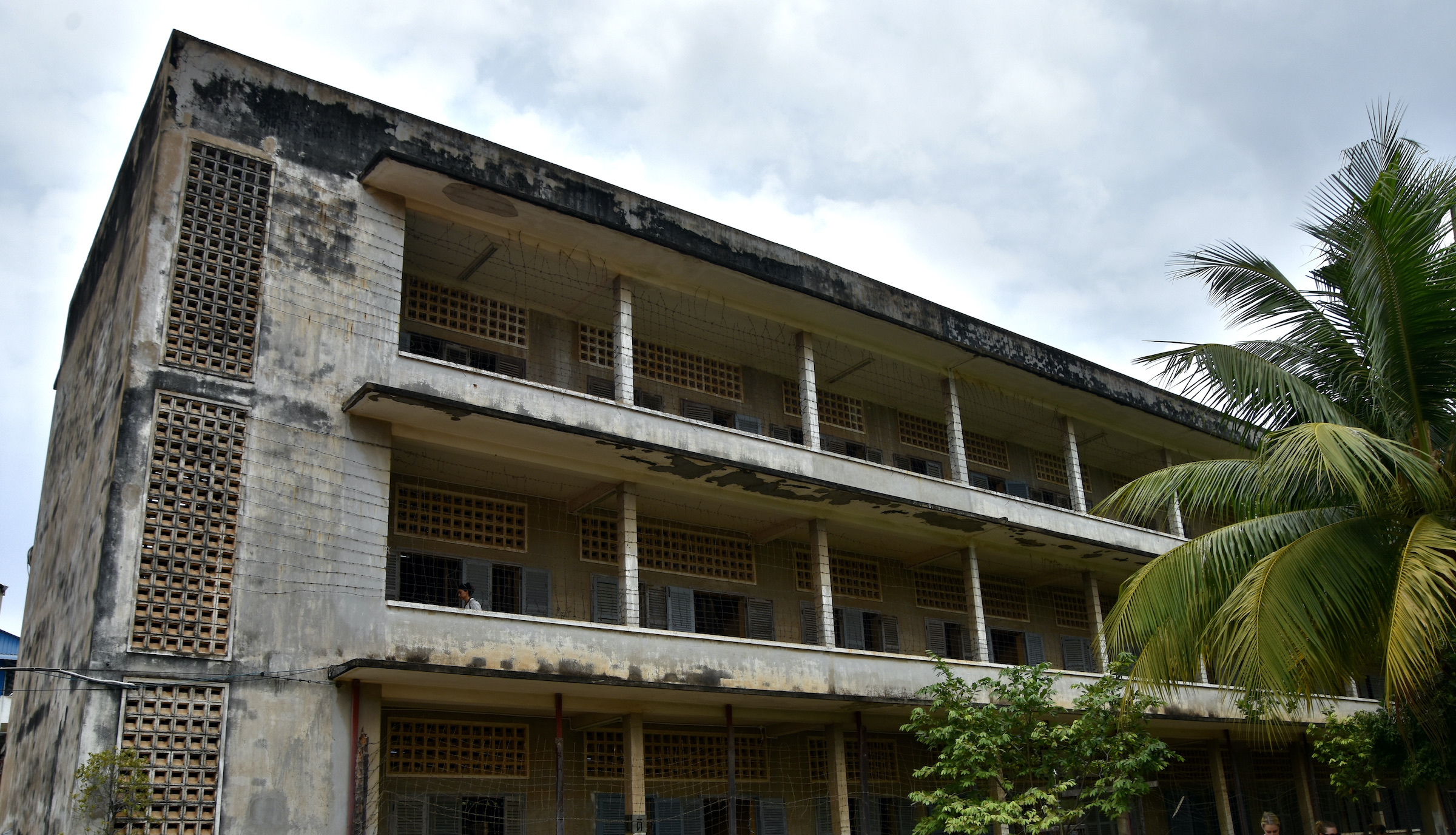
We’ll start our visit not in the countryside where most of the killings took place, but right in the centre of Phnom Penh at a building that used to be the premiere high school in the city. It is now the Tuol Sleng Genocide Museum due to the events that took place here between 1976 and 1979. I should note at this point that the current Cambodian government, which is autocratic and has been under the control of one man, Hun Sen since 1984, does not shy away at all from The Killing Fields episode of their country’s history. Hun Sen started off as a member of the Khmer Rouge, but defected to the Vietnamese in 1977, ostensibly because he disagreed with what Pol Pot was doing. Ever since he took over the leadership of the country at age 26 with help from the Vietnamese, there have been no attempts to conceal from the outside world the horrible events that occurred during Pol Pot’s rule. Almost every tour company that takes visitors to Cambodia now includes The Killing Fields in their itinerary.
S-21 was the equivalent of the Gestapo headquarters for the Khmer Rouge and it was here that the nightmare began for more than 18,000 Cambodians. After taking over the high school and presumably rounding up the teachers, the classrooms were converted into tiny cells like this one.
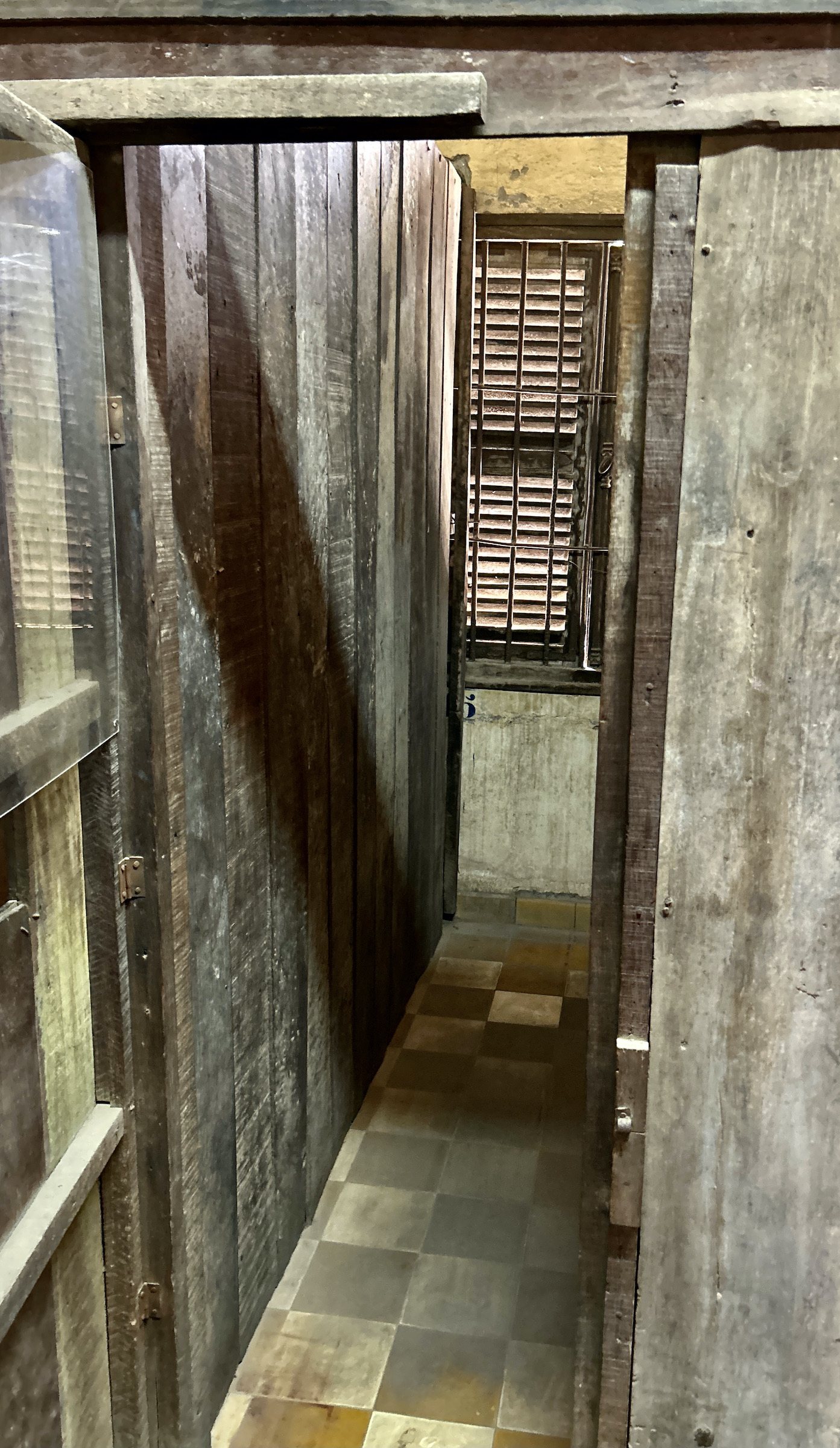
The reasoning, if you can call it that, behind The Killing Fields was very similar to what had started ten years earlier in China, the Cultural Revolution where the Red Guards, who were mostly teenagers and those in their twenties, sought to rid China of the Four Olds – old ideas, old culture, old customs and old habits. They did this by constantly seeking out counter-revolutionaries and re-educating them in concentration camps and if that didn’t work, killing them. This lasted until Mao’s death in 1976, the same year things got underway in Cambodia.
As in the Cultural Revolution, children became informers on their family and friends and in order to survive you had to be a more faithful adherent to the madness than anyone else. The result was that someone accused you of being an enemy of the state and you found yourself taken to a place like S-21. It was important for the Khmer Rouge that the accused confess their crimes and according to these rules you essentially were guilty no matter what you had done. If you were here you deserved to be here. This is stuff right out of George Orwell’s 1984 and it actually happened before 1984 even arrived.
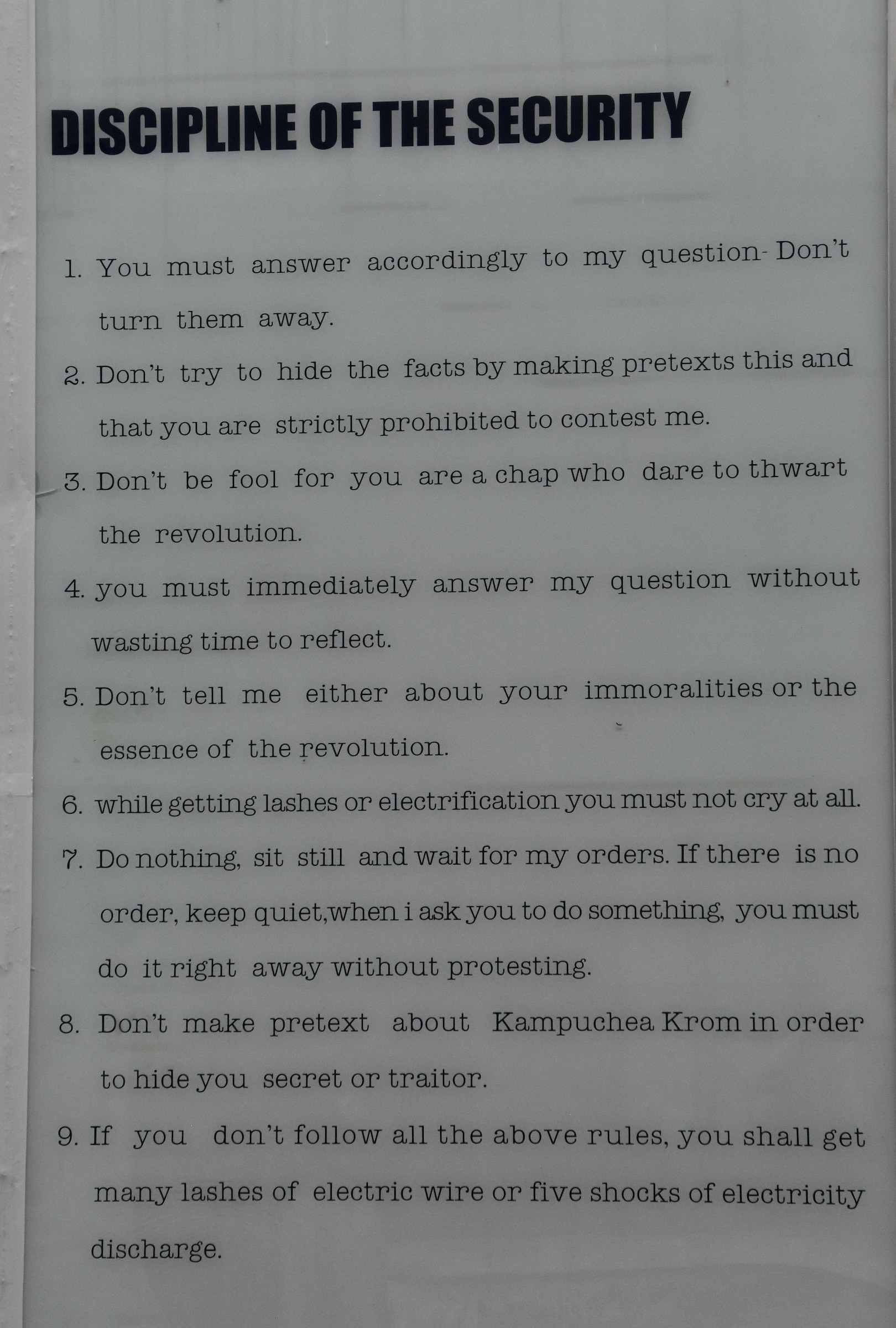
Like the Gestapo and other secret police organizations, the Santebal which was the official name of the Khmer Rouge thugs, was populated with sadistic murderers who delighted in all forms of torture to get the required ‘confessions’ before the victims would be shipped off to The Killing Fields to be finished off. According to Cambodian records some 18,145 persons were imprisoned here of which 18,133 were subsequently killed. While many died in the prison from the torture inflicted others were subjected to fatal medical experiments along the lines of those conducted by Josef Mengele and others at the Nazi concentration camps.
OK, with that brief outline let’s venture into the horror show that was S-21. Warning – there are some graphic and disturbing photos in the rest of this post.
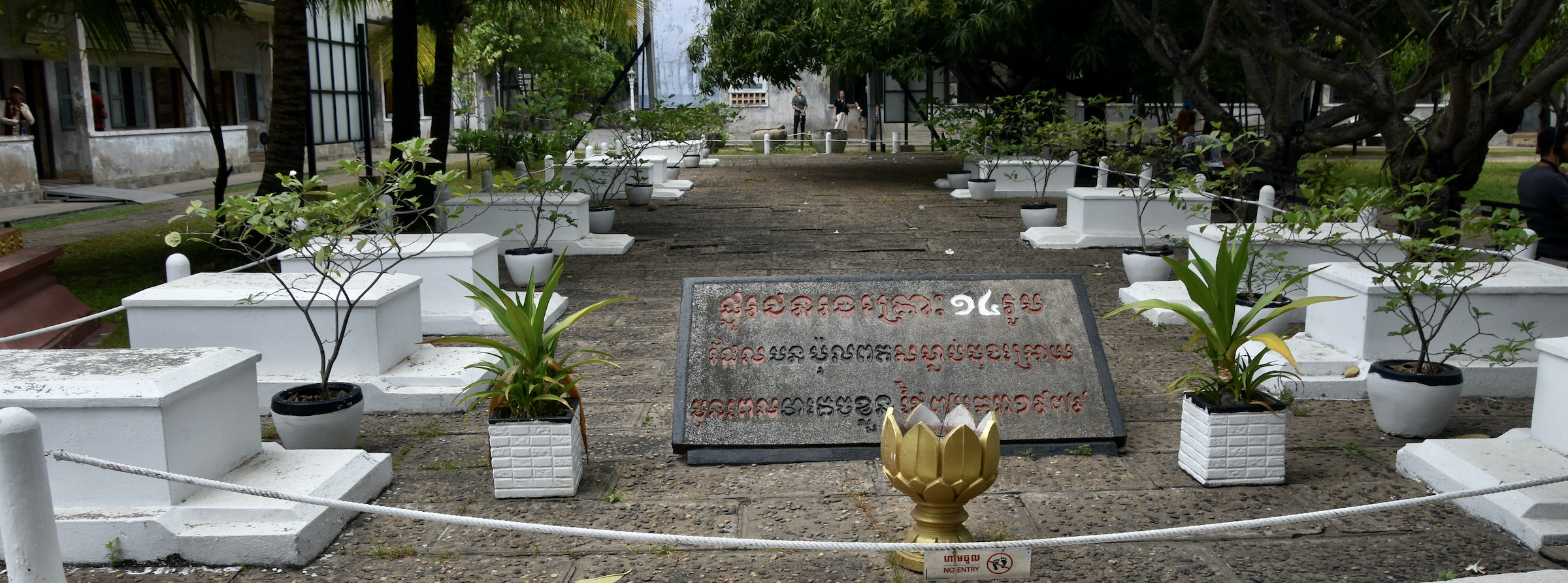
These are the graves of thirteen people who were found by the Vietnamese in the so-called VIP cells when they liberated S-21 in 1979. Ironically after killing all the elites, the minorities, the foreigners and many other groups, the Khmer Rouge turned on themselves and by 1979 many former high ranking members now found themselves as guests here. They each had there own cell and were manacled to a bed where they were simply left to die. This is a photo of one of them as taken by the Vietnamese upon opening the cell. Just a rotting putrescent corpse.
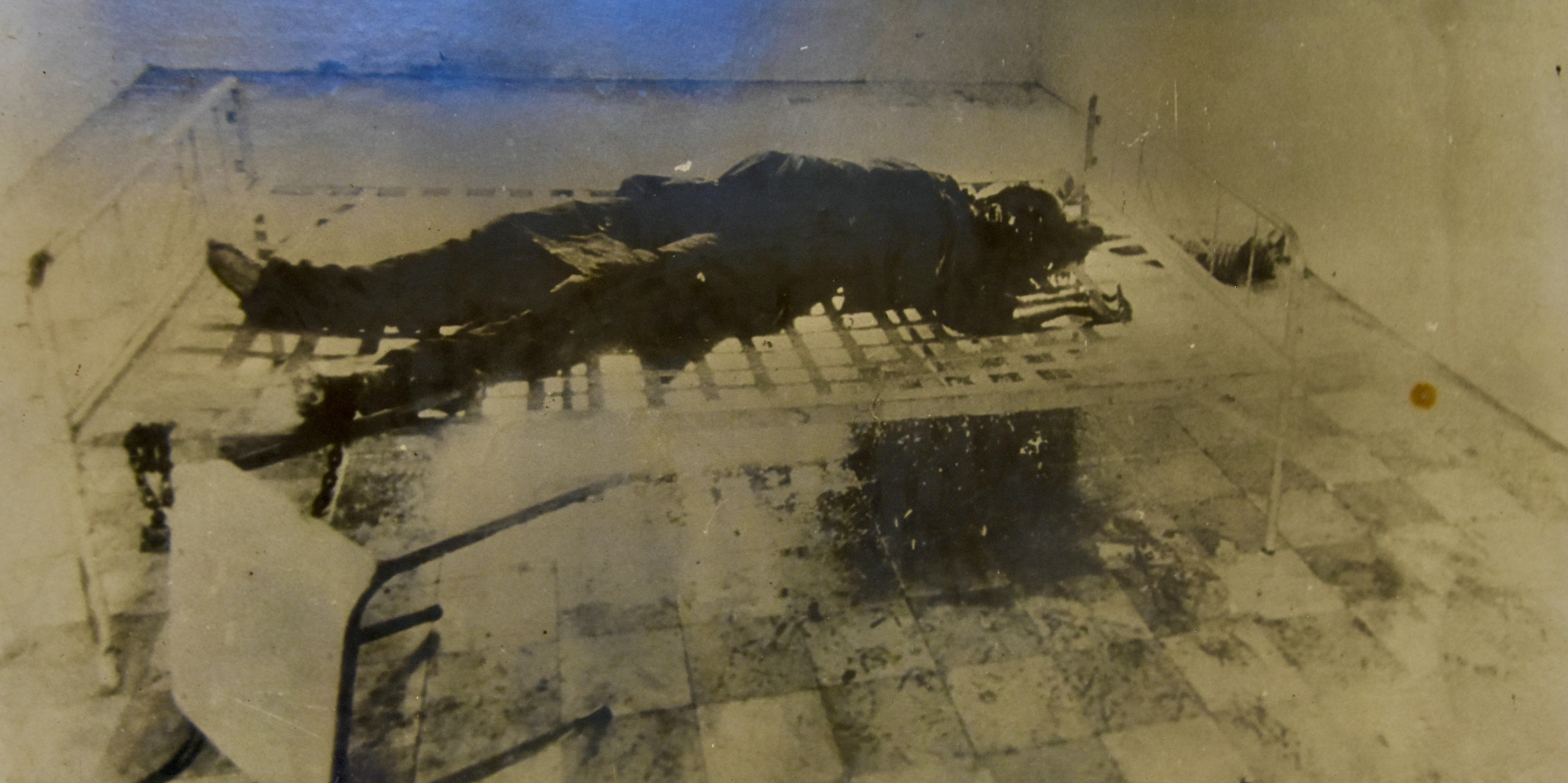
Just like the Nazis, the Khmer Rouge had a set routine for people sent to their prisons. They were all photographed and asked for their autobiographies. To me, the most disturbing part of visiting S-21 were the photographs of both the victims and the perpetrators. These are all victims.
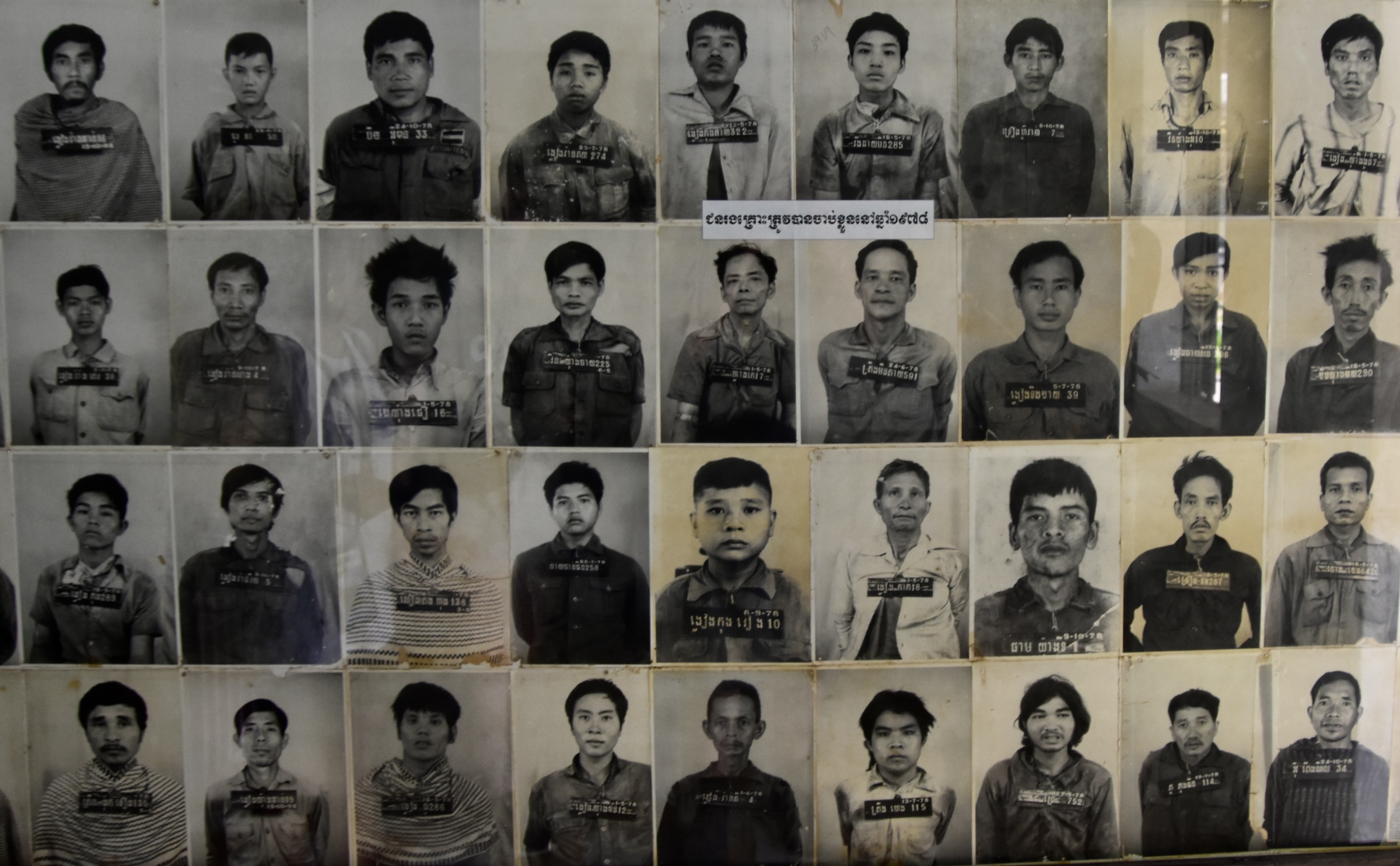
And women
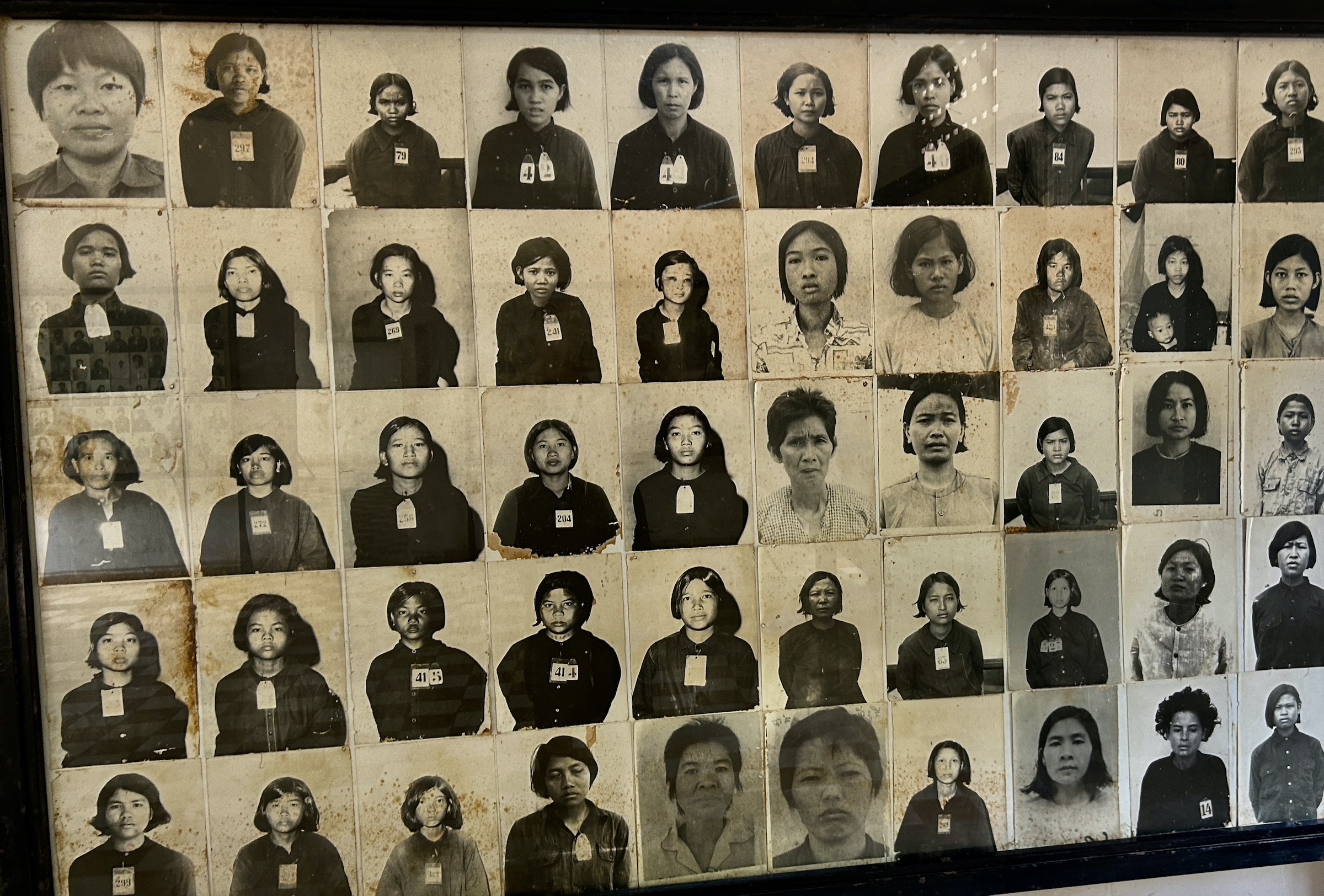
And even children.
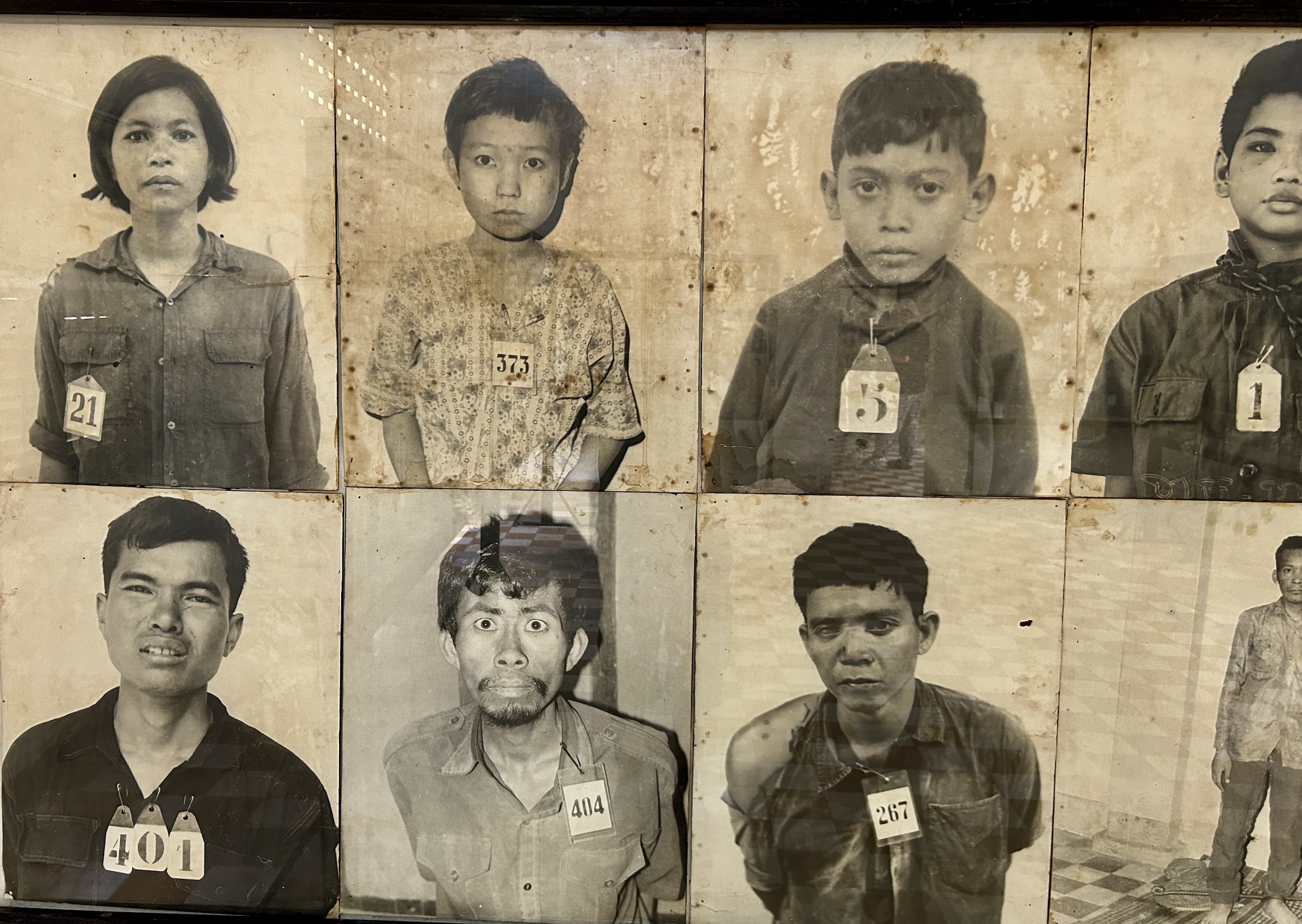
Note that they are all overwhelmingly young people.
And these are their accusers.
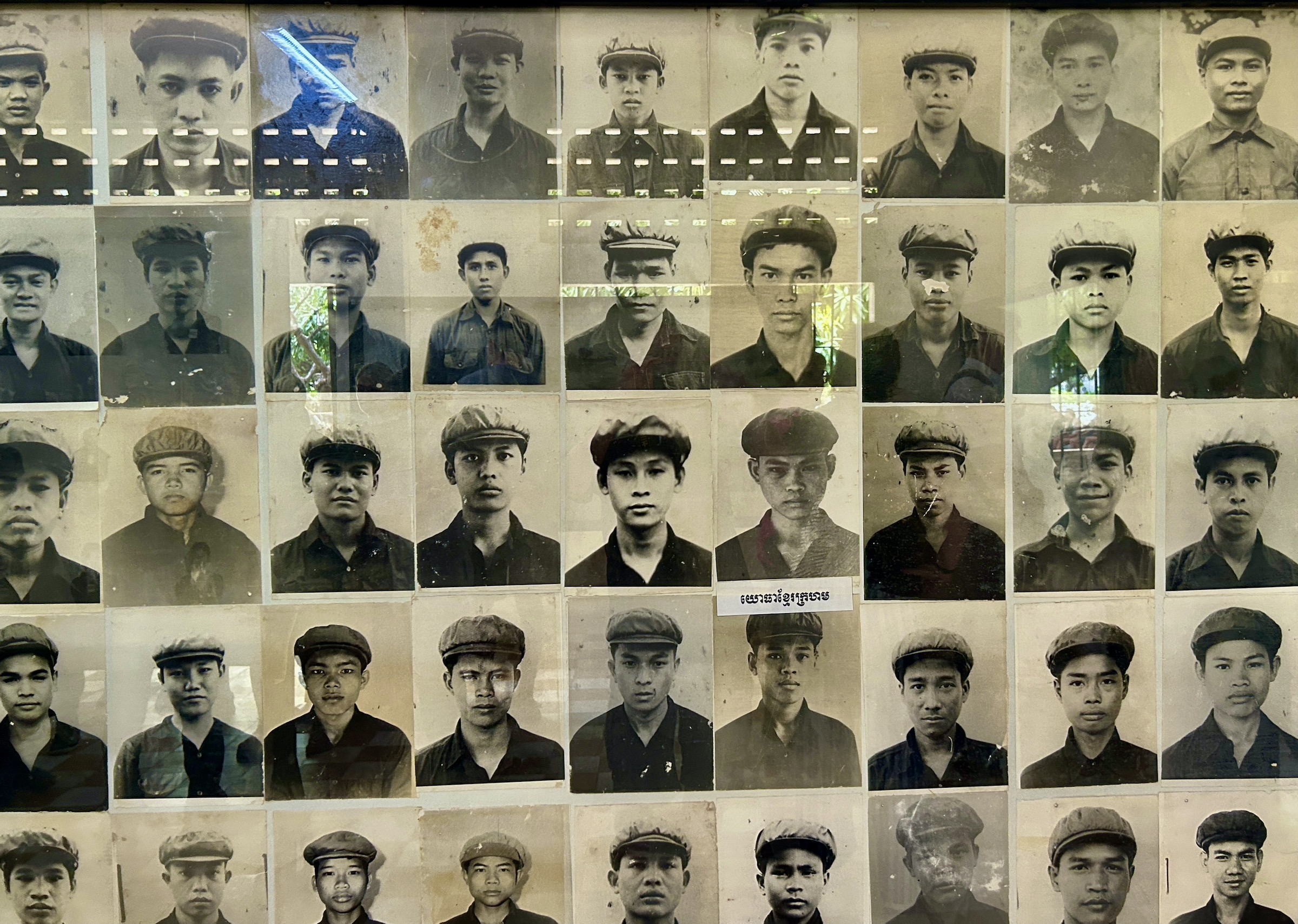
And women.
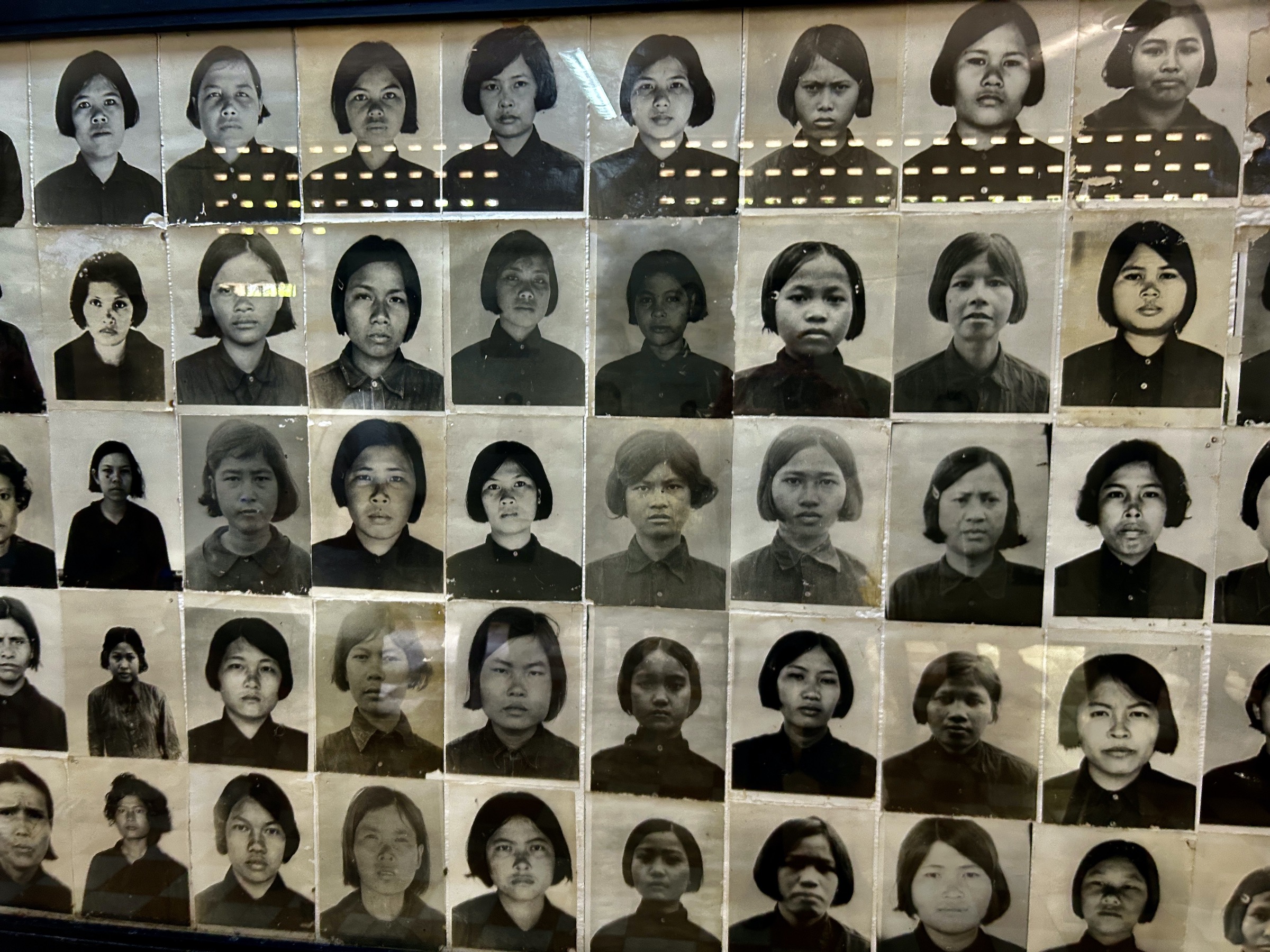
Also overwhelmingly young and no different looking than the ones they accused. Hannah Arendt coined the term ‘The banality of evil’ in reference to Adolph Eichmann and nothing proves it more true than these photographs.
Perhaps the most horrific one of all is this one – before and after – alive and dead.
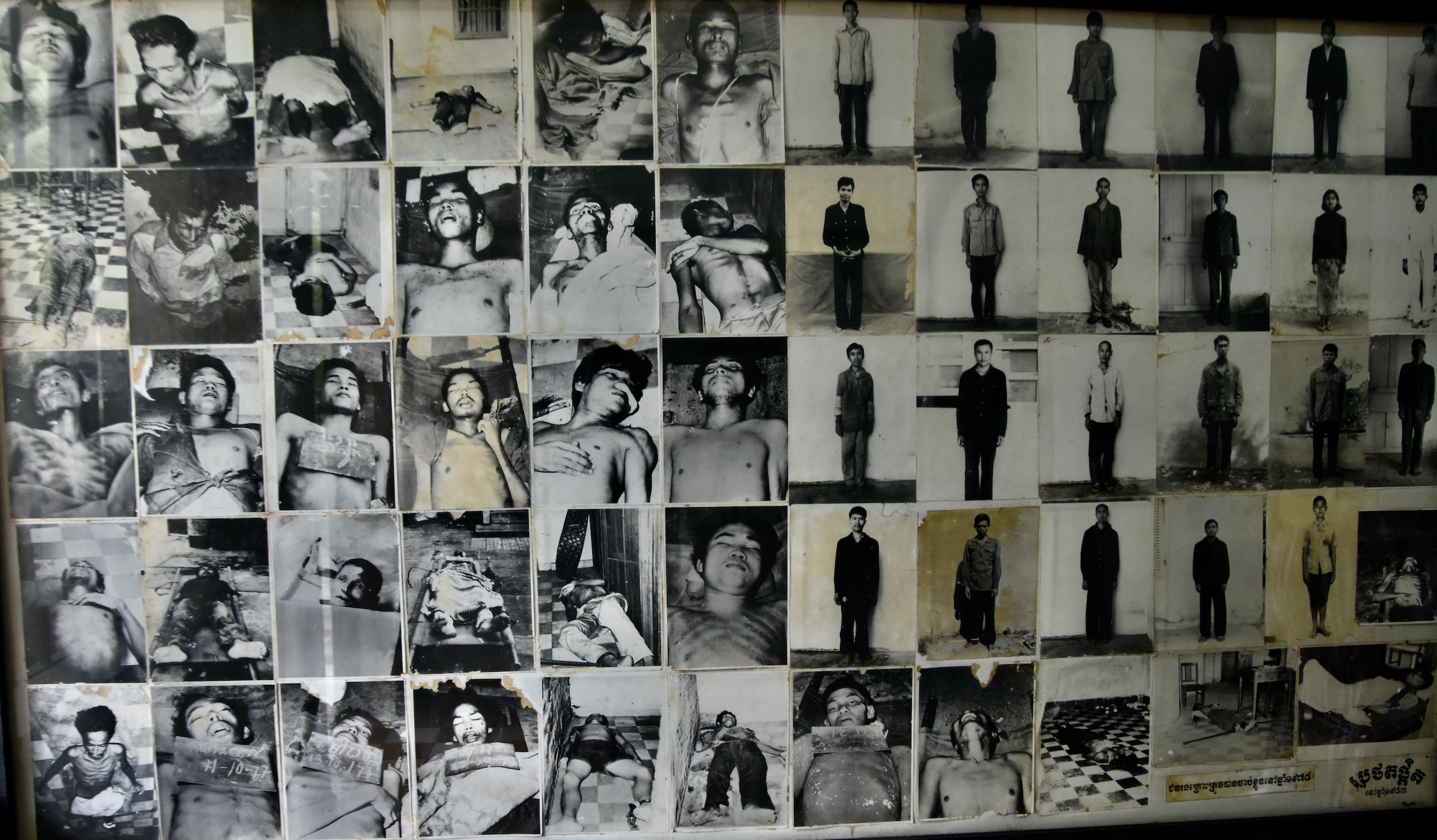
A visit to S-21 is not a pleasant experience, in fact I would call it heart sickening and it made me want to try to smash one of the Pol Pot busts that are in storage at the place.
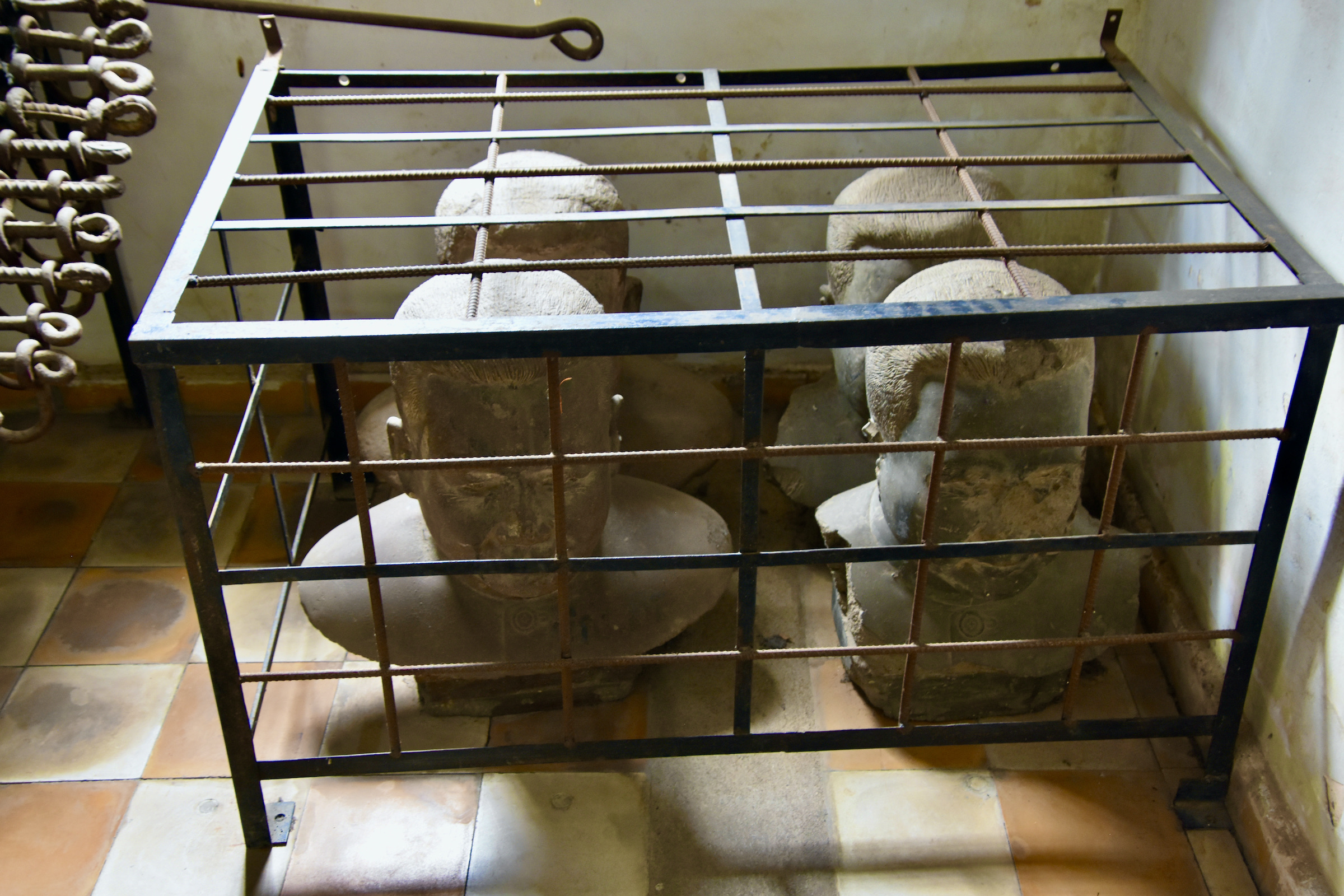
As I looked out at the city of Phnom Penh through the barbed wire as I’m sure thousands of those doomed souls did, I could not but help think of the dangers of ideology gone haywire as it did from both the left and right in the 20th century and as it threatens to do today.
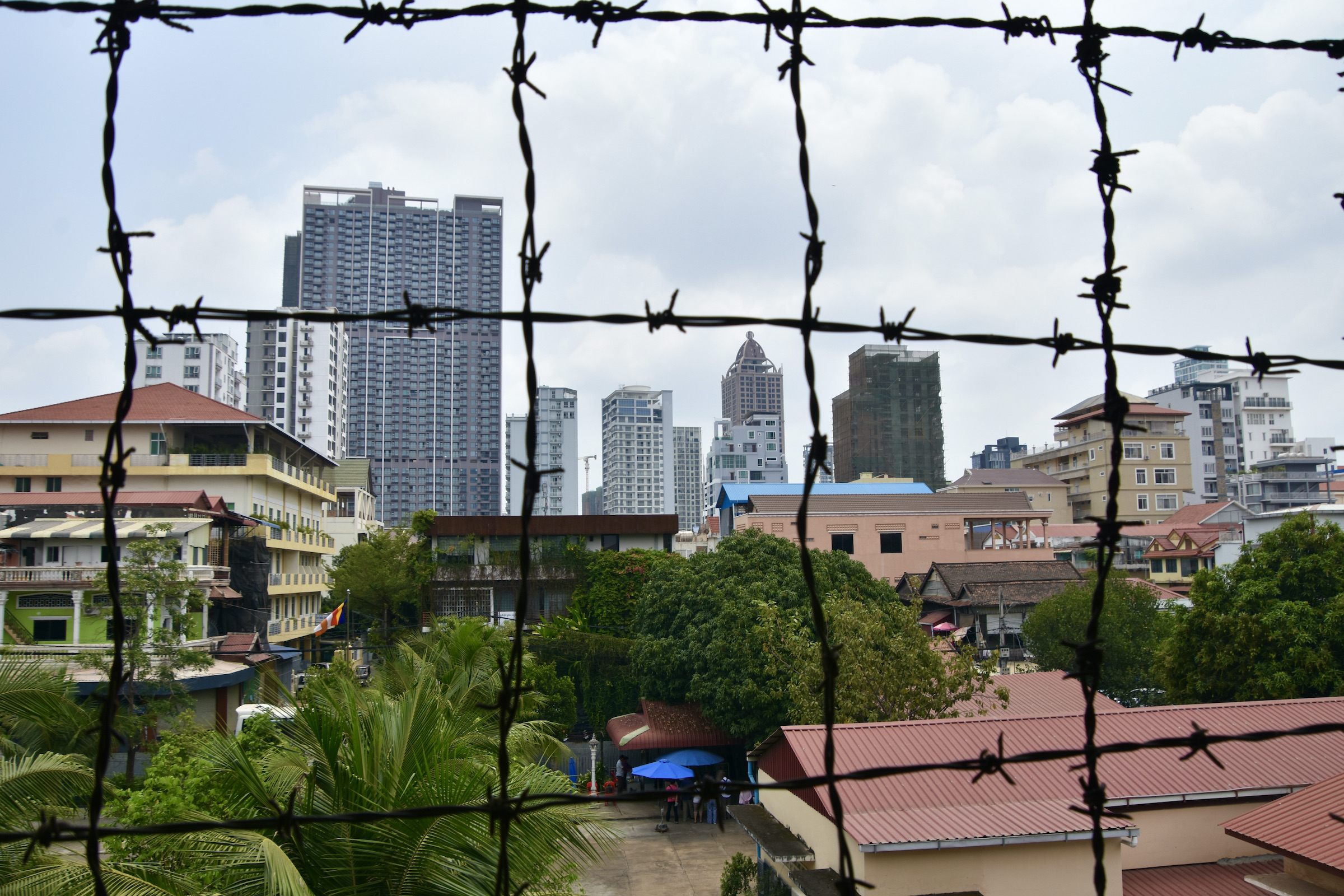
Choeung Ek Genocidal Center

If you didn’t die in S-21 prison you were shipped to Choeung Ek, once a peaceful orchard just south of Phnom Penh, to be summarily executed. In North America the words ‘truck stop’ usually have a positive connotation, but not at The Killing Fields where it meant the last stop before certain death.
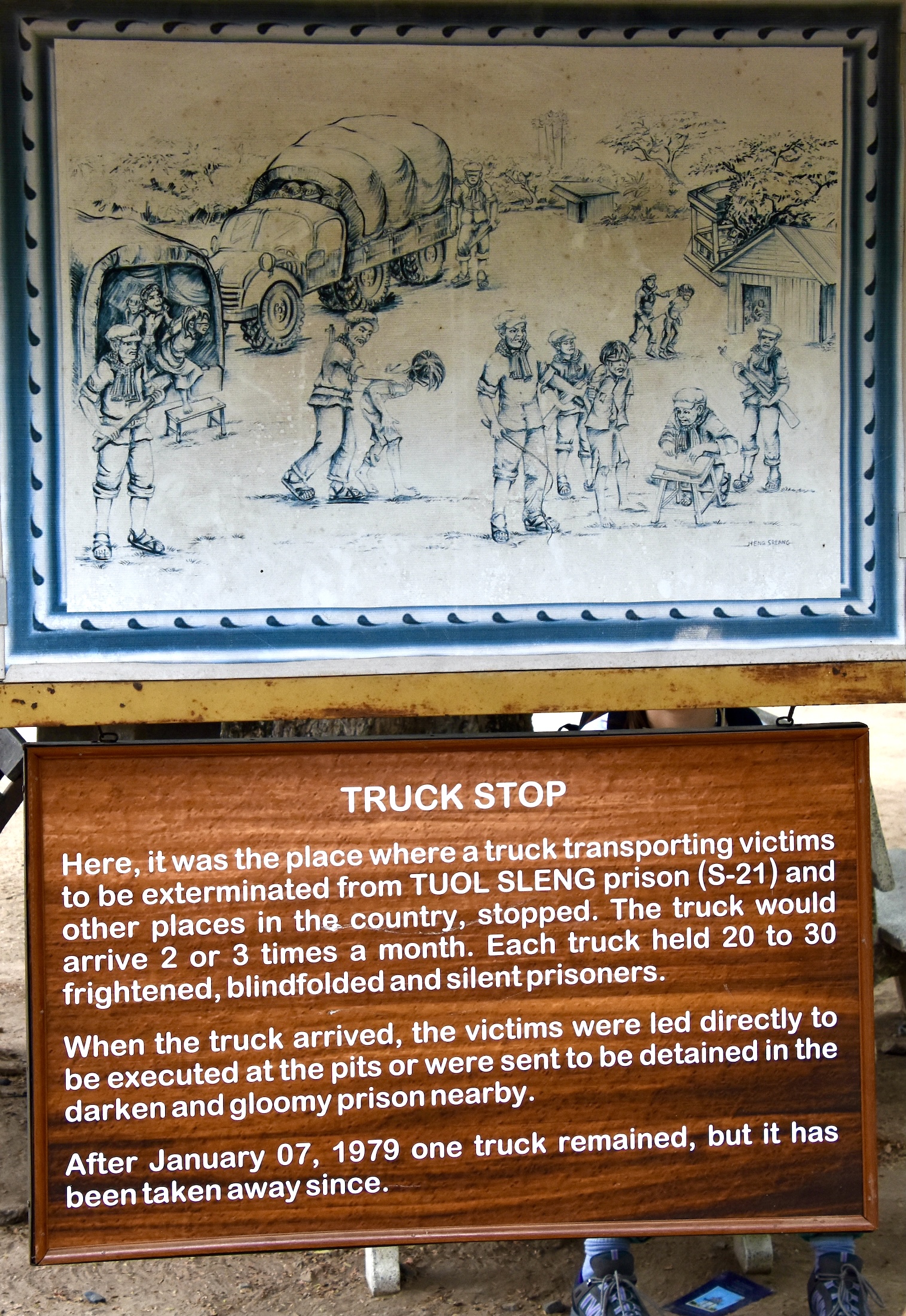
After the Khmer Rouge were ousted almost 9,000 bodies were exhumed from mass graves around this site. Many, if not most, of the victims have not been identified and their skulls are perhaps the most well known symbol of the horror that was The Killing Fields. There are over 5,000 of them in the stupa that was built to hold them in 2012.

They are piled up the entire side of the stupa.
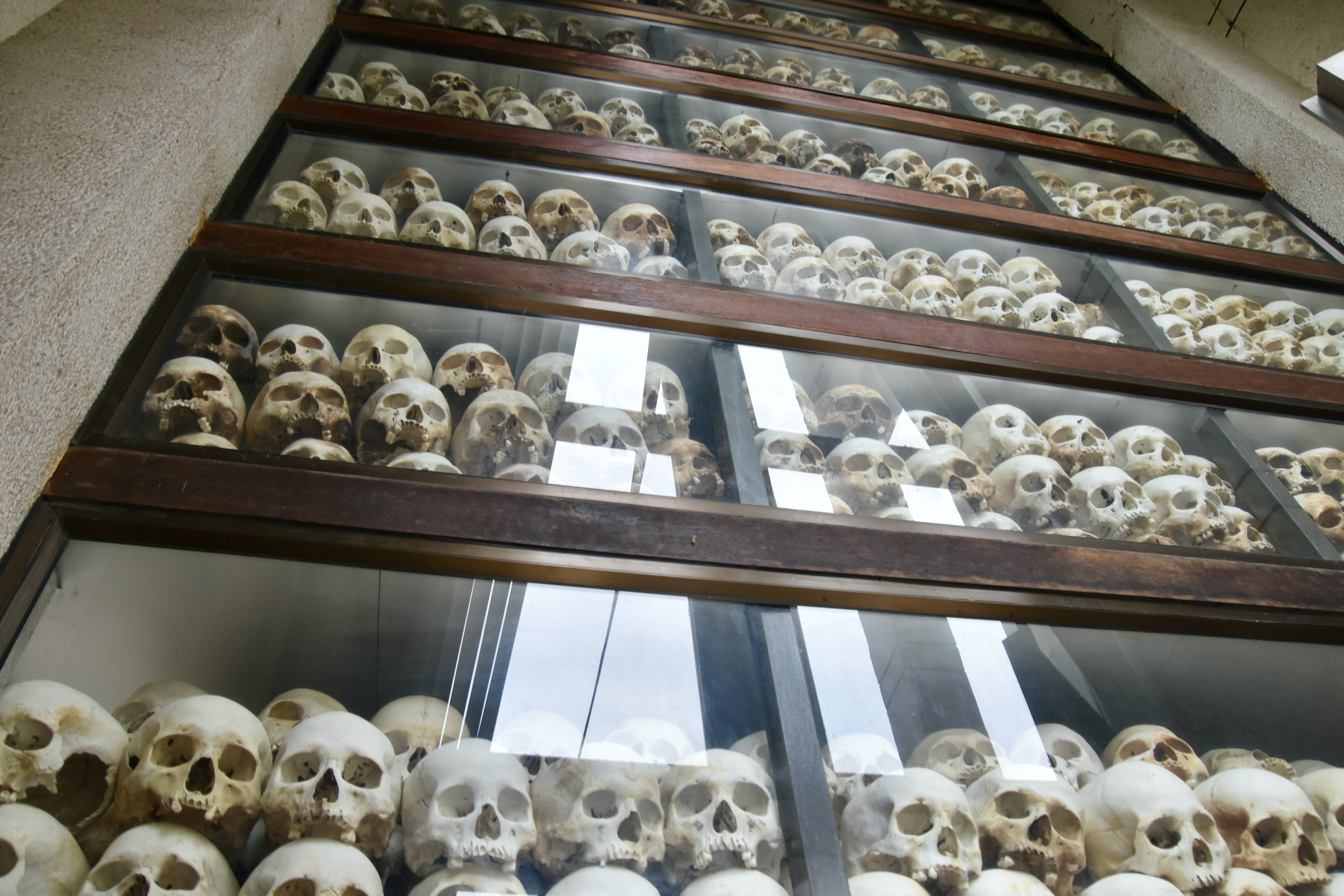
Perhaps the most horrifying aspect of the murders is the manner in which they were carried out; not with bullets, but with axes, knives, crowbars or anything that could kill a human being. It’s one thing to herd helpless victims into a gas chamber and push a button to release the gas from a safe distance and quite another to be only a few feet from your victim and bring an axe down on their head. And this was done well over a million times by thousands of different executioners.
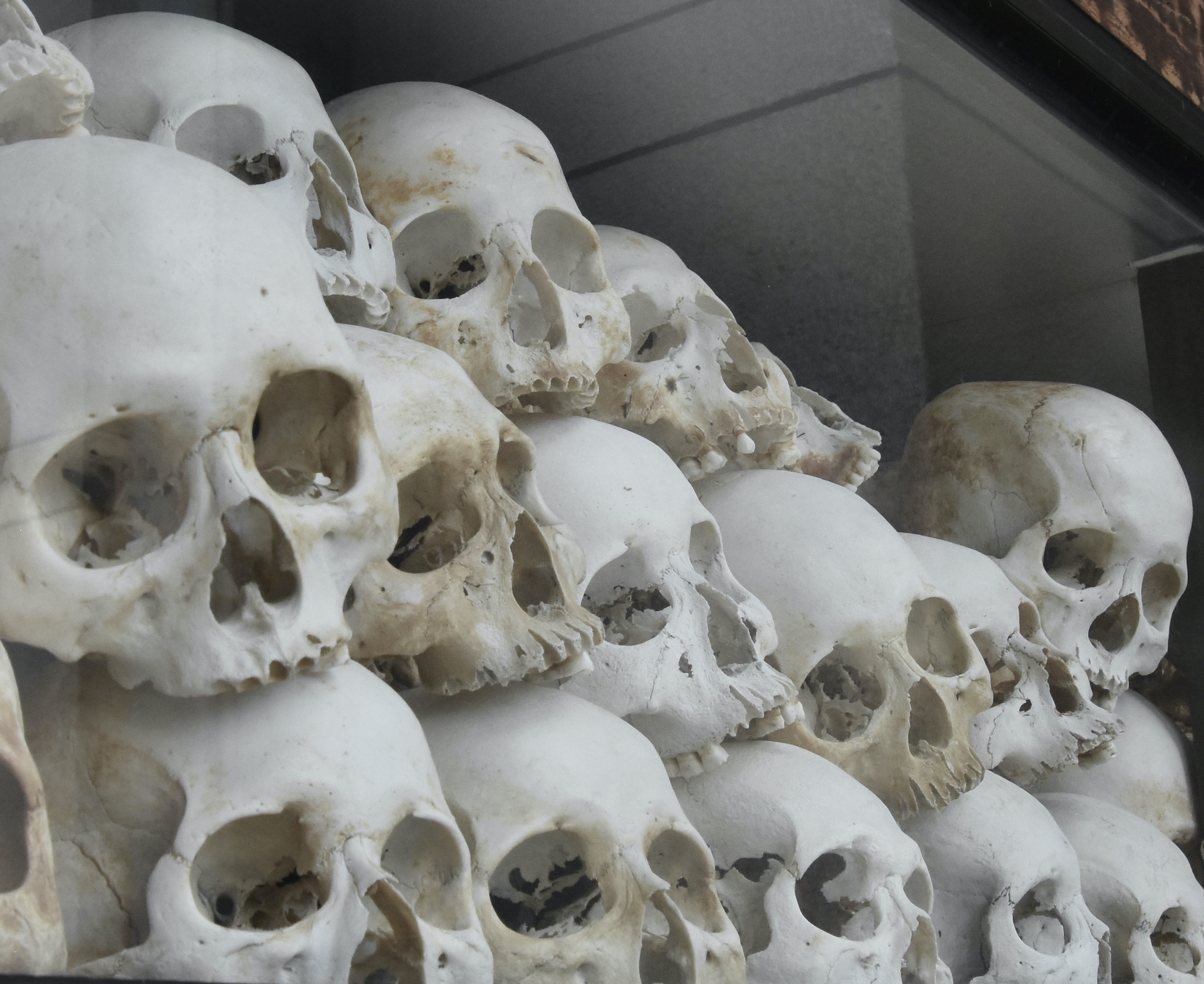
After visiting the stupa, there is a dedicated pathway that takes you past some of the excavated burial sites. This is our local guide Tonh leading the group through one of The Killing Fields.
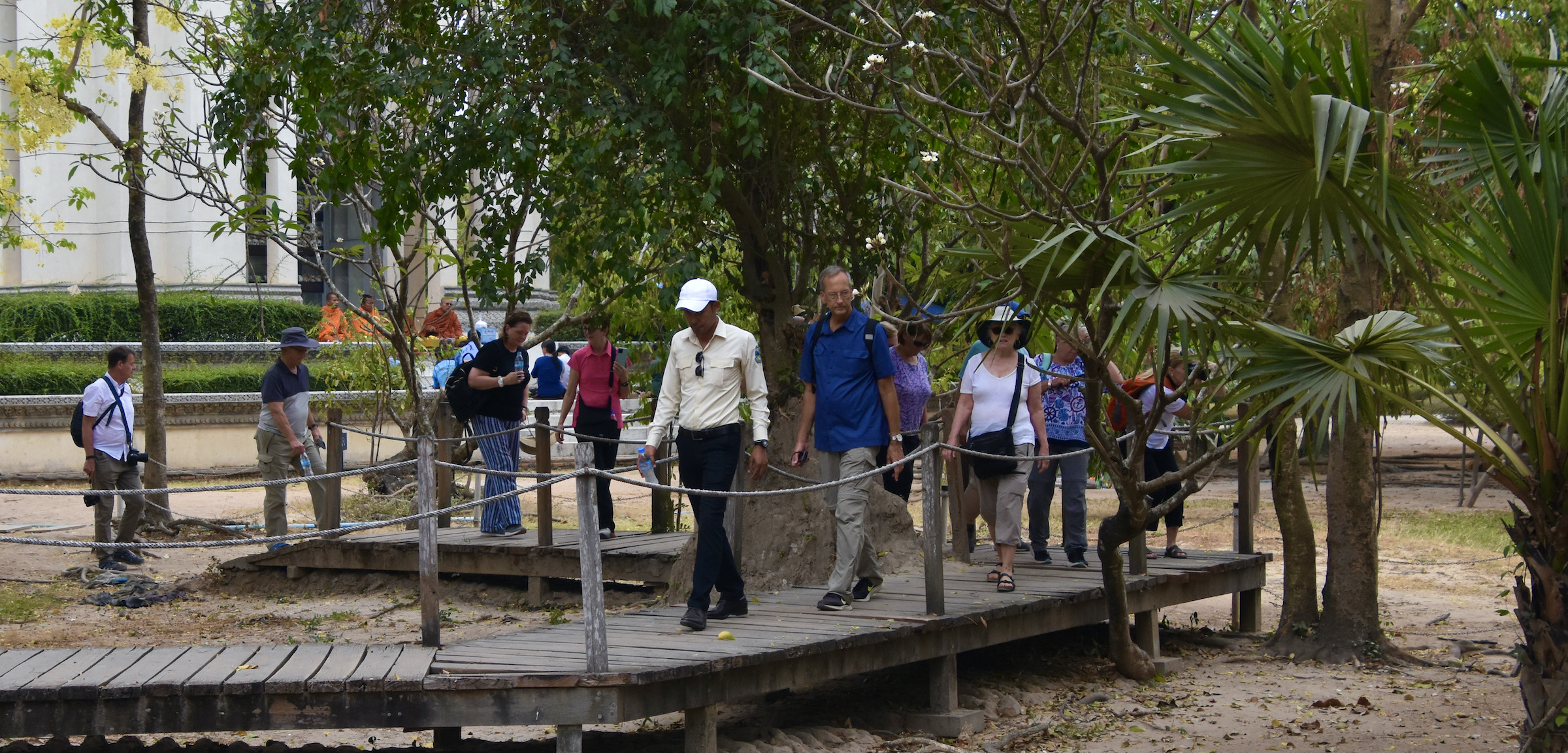
Initially I thought the most shocking thing was the fact that there were still bones and teeth just lying around in many places.
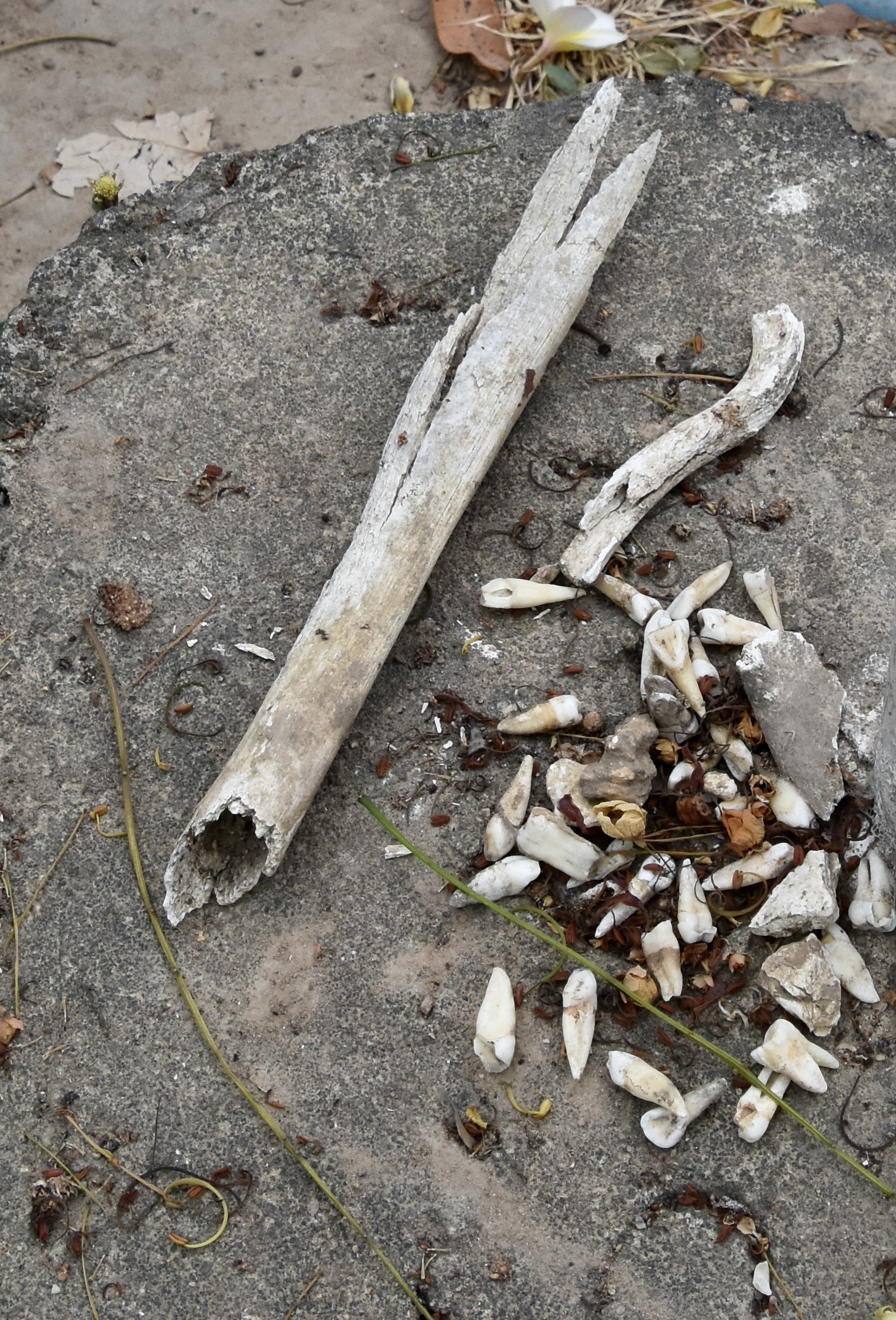
But what really brought home the recency of this horror were the fragments of clothing. I’ve seen bones and teeth in lots of places, but they’re usually hundreds if not thousands of years old and there is no tangible connection with my lifetime. However, seeing the clothes of the victims almost caused me to vomit.
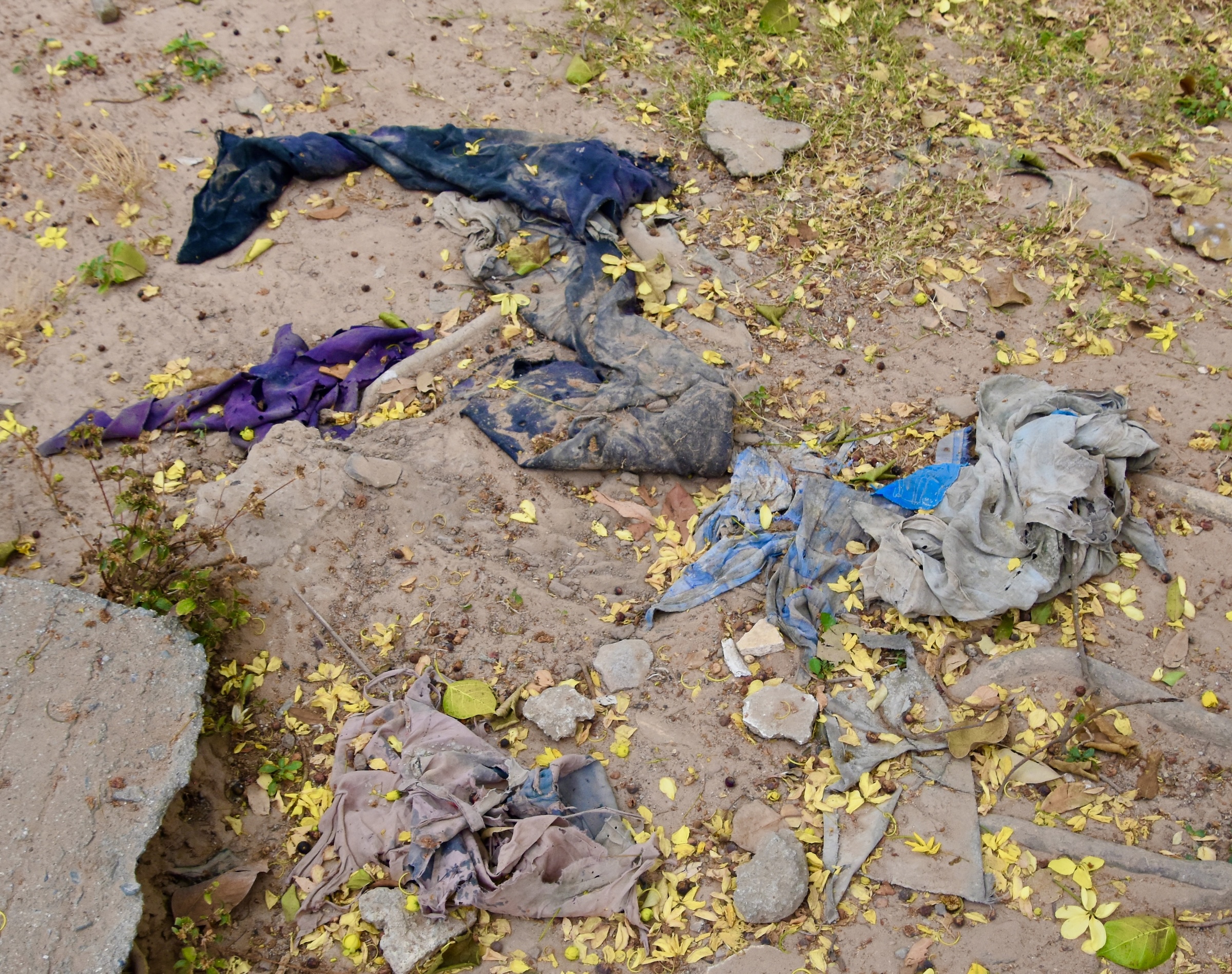
There was one final horror at The Killing Fields that will haunt me for a long time. I debated not showing this, but if you go on this tour it might be wise to be prepared for it. This is the Killing Tree. Young children and babies were held by the legs and had their brains bashed in as their bodies were swung like a baseball bat against the tree.
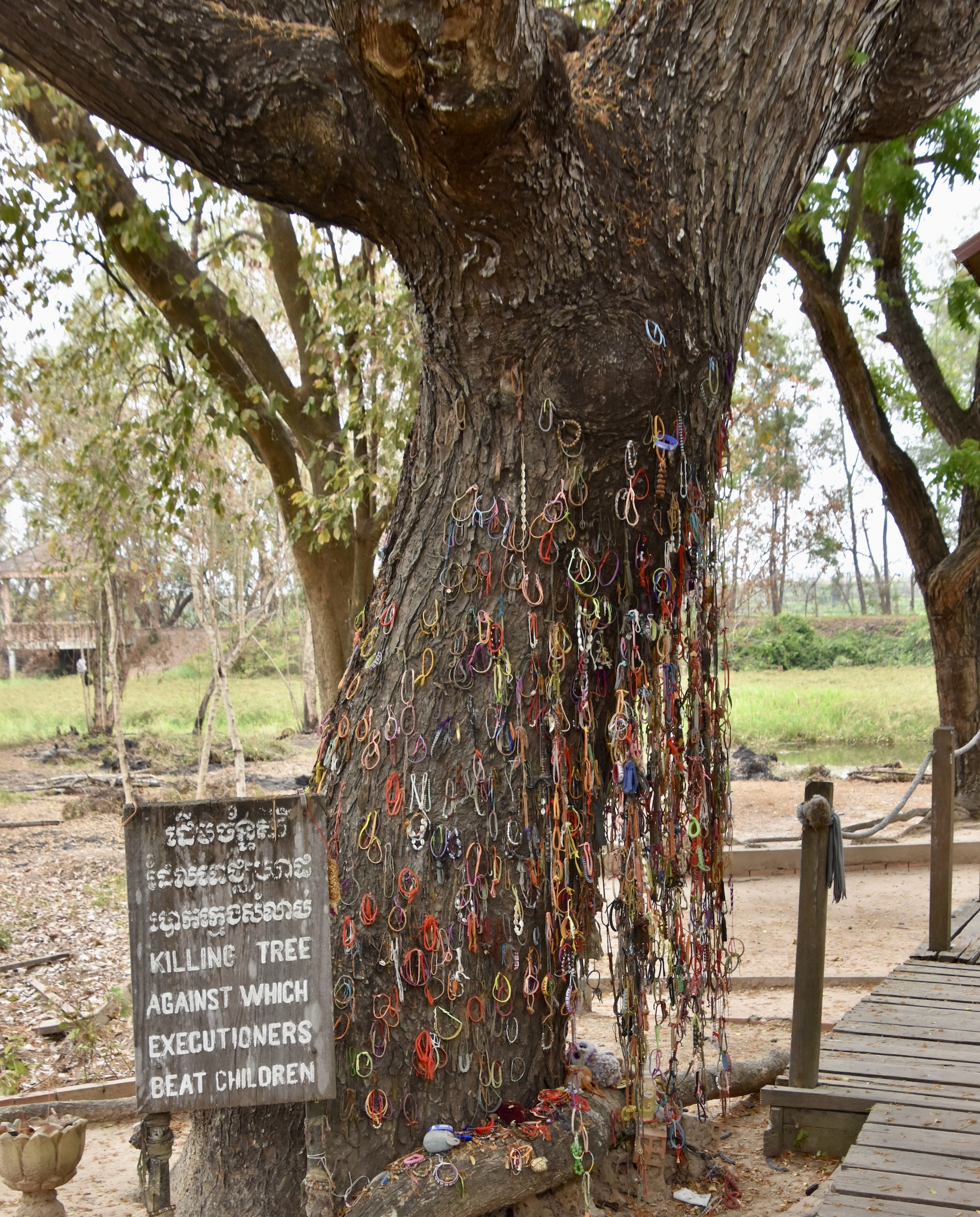
We returned to the stupa where a group of Buddhist monks were chanting with rows of skulls in the background. We stopped to listen because, frankly our nerves needed calming after taking that walk and the chanting was somewhat soothing.
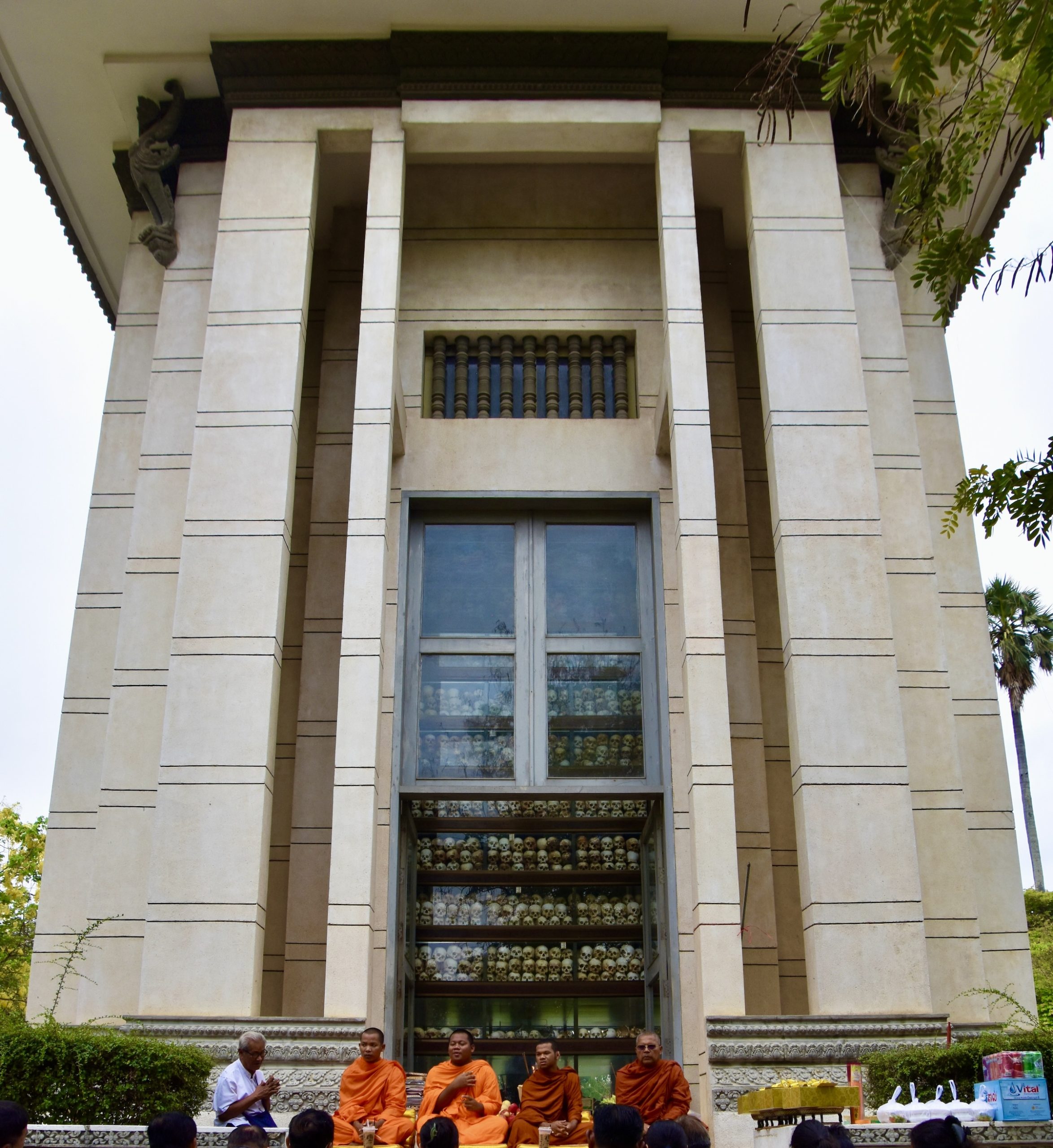
We ended our visit to The Killing Fields by making a donation and placing lotus flowers in a memorial container.
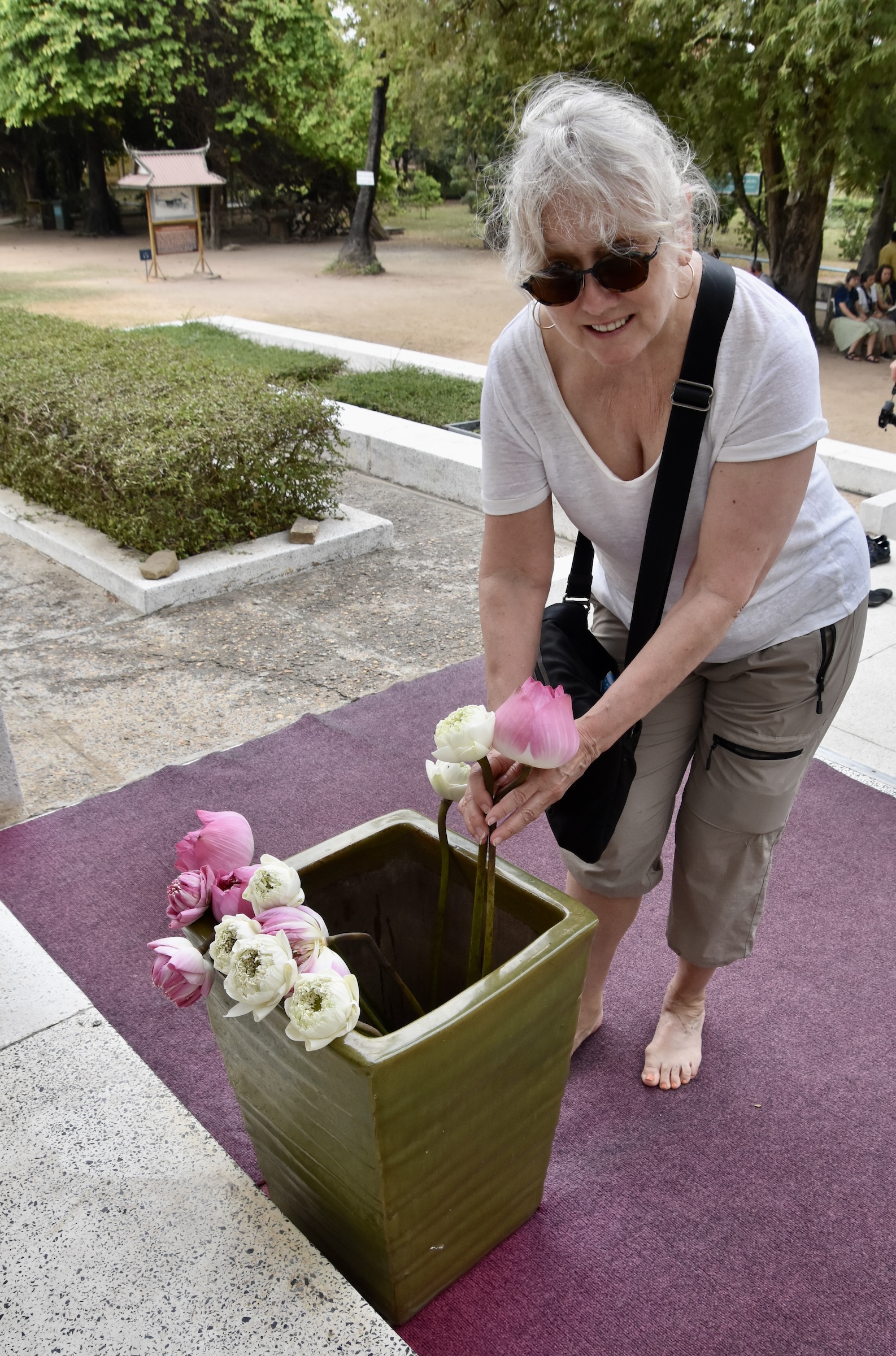
The reason we travel is not only for the pleasure it brings, but also sometimes the pain; a pain brought on by a better understanding of the dark side of humankind. I wouldn’t want to make such things the primary focus of any trip, but neither would I shirk the responsibility of learning about them and I’m glad Adventures Abroad didn’t either.
In the next post we’ll head to Siem Reap and perhaps the highlight of this entire tour, the temples of Angkor Wat.

